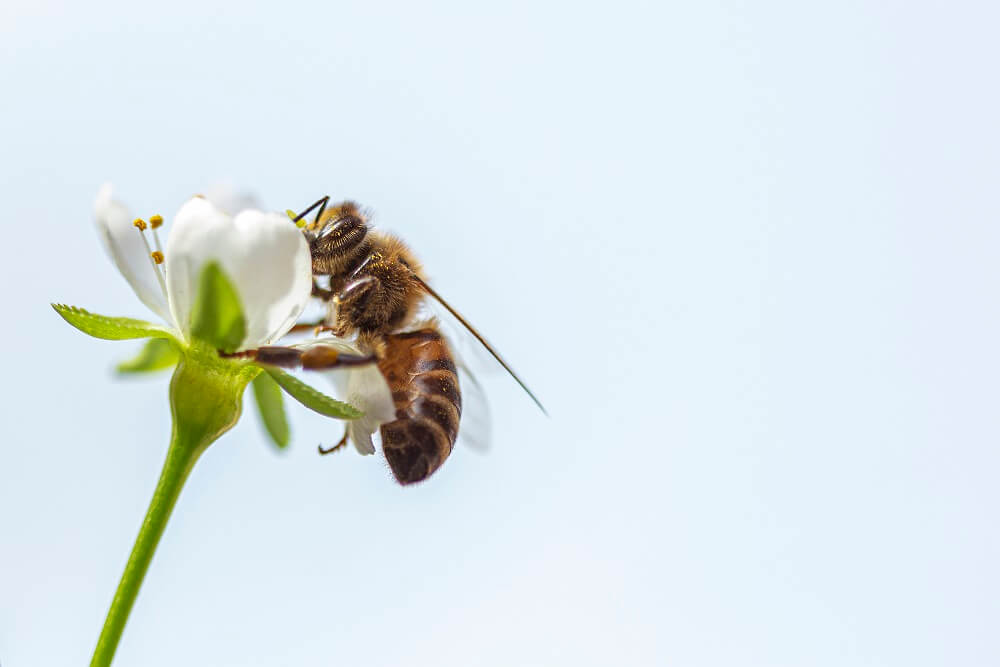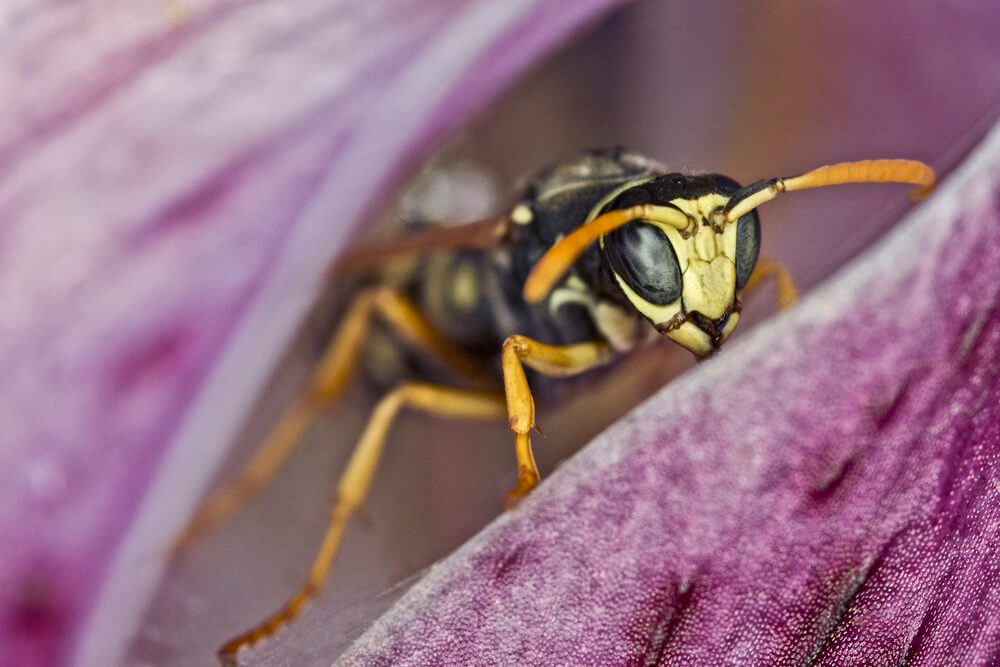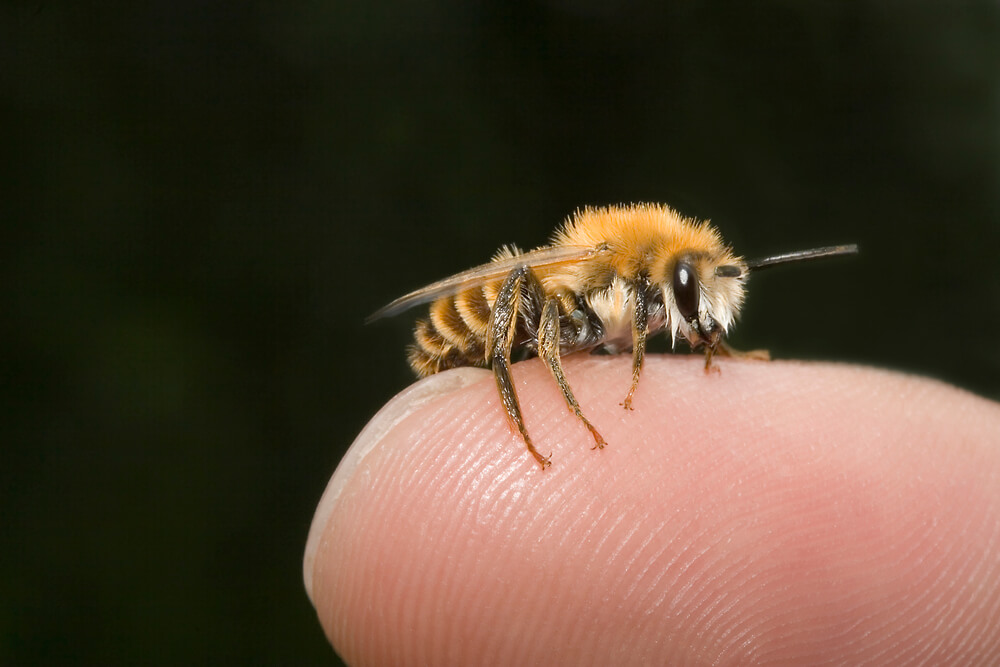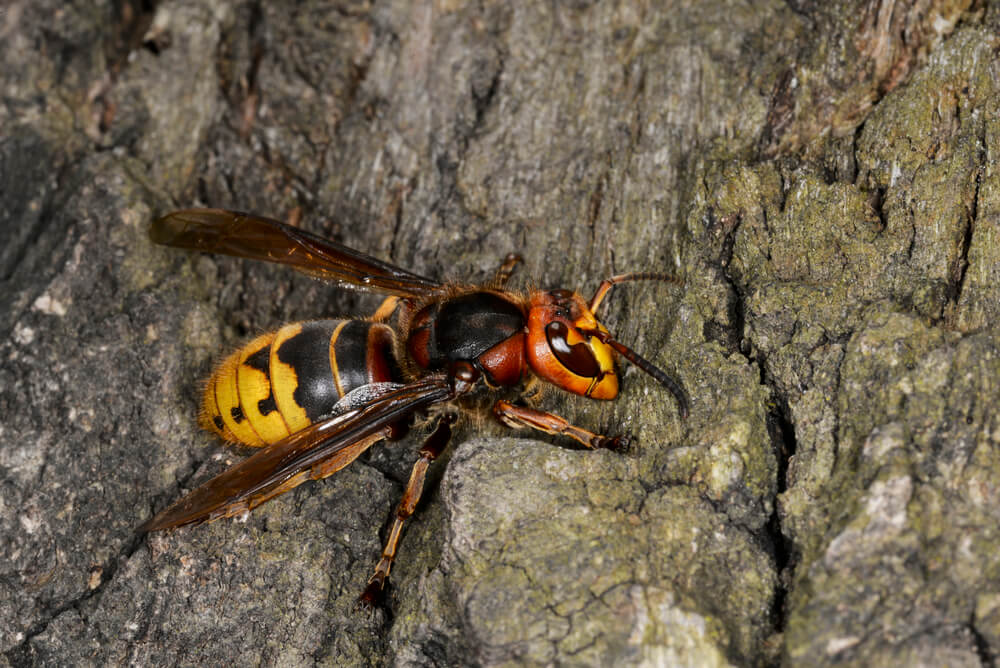In this article:
How Many Legs Do Bees Have?
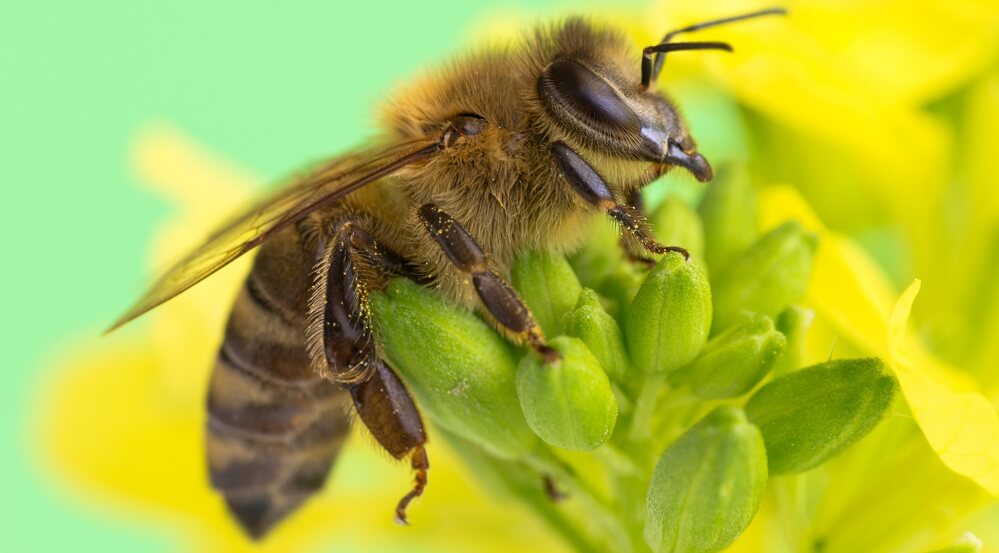
Bees have six legs:
- two forelegs (at the front of their body)
- two middle legs
- two hind legs
But there’s something I need to address.
I often hear people asking, “How many legs does a queen bee have?” or “How many legs do bumblebees have?”
The answer is that all bees have six legs, regardless of whether they’re a honeybee, bumblebee, mason bee, etc. That said, the purpose of the legs varies based on the type of bee.
And here’s the cool part:
Bee’s legs aren’t quite the same as those of other insects. For example, many other bugs just use their legs for walking and mobility.
But bees?
They use their legs for all sorts of things, including hearing, grooming, and even tasting.
Wait, bees use their legs to hear and taste?
Yup. So let’s discuss that next.
Related: Do Bumble Bees Make Honey?
Why Do Bees Need Six Legs?
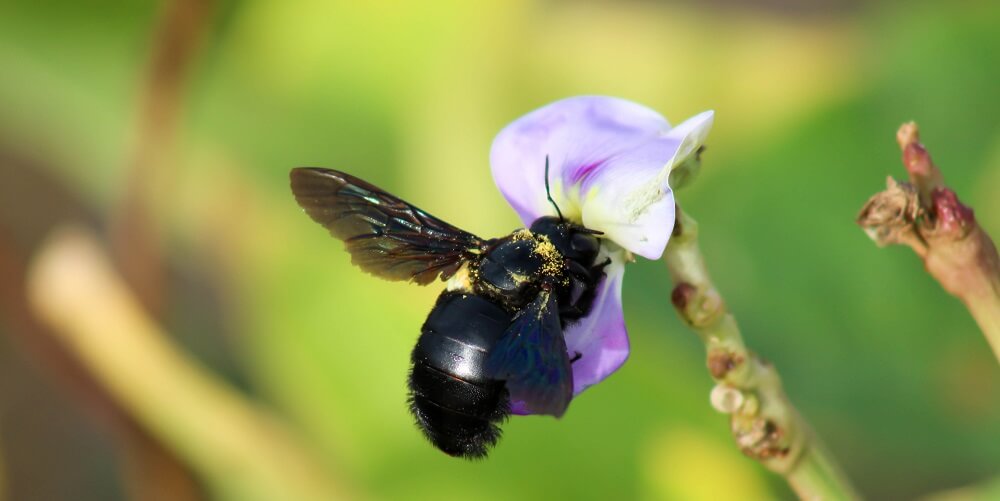
Let’s face it.
Bees are busy little creatures.
They can work up to 12 hours per day foraging for pollen and nectar. This is where their legs (and other body parts) come in.
For some activities, bees put all their legs to work. For others, they only use one set of legs to handle the job.
So what are some specific ways that bees use their legs? Let’s talk about a few:
Related: Honeybees vs. Bumblebees: How Do They Compare?
1. Bees use their legs to taste things
You read that right.
Bees’ taste buds are hair-like structures found on their legs, antennae, and mouth. These hairy sensors contain nerve cells in them that allow them to taste things. This is how they check flowers for nectar.
So how do they do it?
It happens very fast. As soon as a bee lands on a flower, they use their feet to taste the flower to see if it’s worth feeding on. If the flower doesn’t contain nectar, the bee flies to another flower.
And more importantly?
This method of tasting things with their legs allows them to be more efficient. If you’ve ever seen a bee buzz around from flower to flower, you’ll notice that it happens incredibly fast. They have no time to waste.
Related: How Many Eyes Does a Bee Have?
2. Bees use their legs to collect pollen
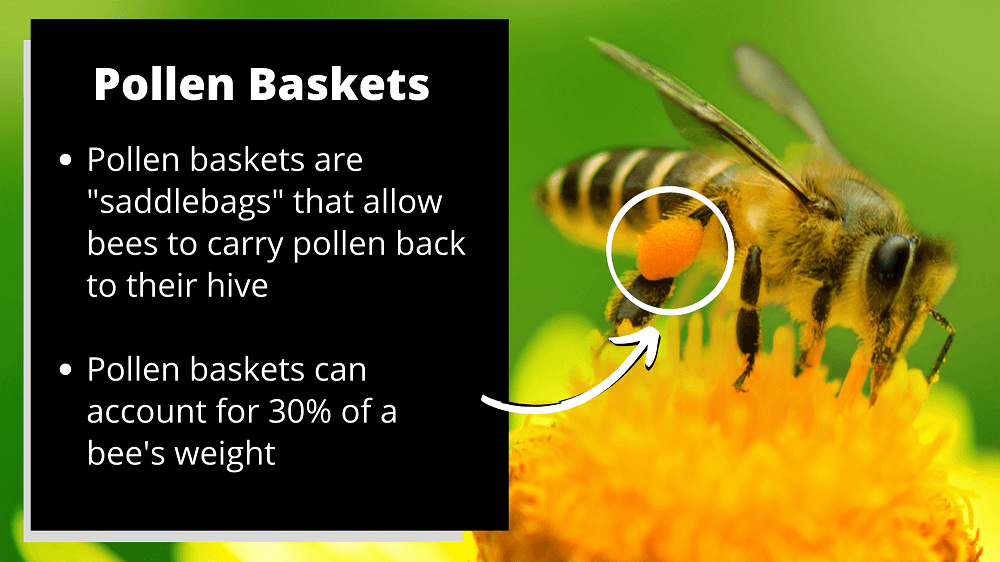
The back legs of many bee species are used to gather pollen from flowers. Pollen is a bee’s main protein source and it also provides fats, minerals, and vitamins.(1, 2)
In fact, bumblebees and honeybees have dedicated “pollen baskets” that they use to store pollen. The bee pushes the pollen she collects on her body down towards her hind legs. From there, she mixes the pollen with nectar and packs it into her pollen basket.
Once these pollen baskets get full, she heads back to the hive to unload them.
Interestingly enough?
You won’t always notice a bee’s pollen basket because it depends on whether it’s full or empty.
You see, bees make multiple trips back to the hive. And when they empty their pollen baskets, they become small and unnoticeable. Their pollen baskets only become visible once they start stuffing them with pollen.
But here’s the thing:
In the US and Canada, only bumblebees and honeybees have pollen baskets. Other bee species just carry pollen around on their hairy legs – minus the designated baskets.
Related: How Long Do Bees Live?
3. Bees use their legs to hear
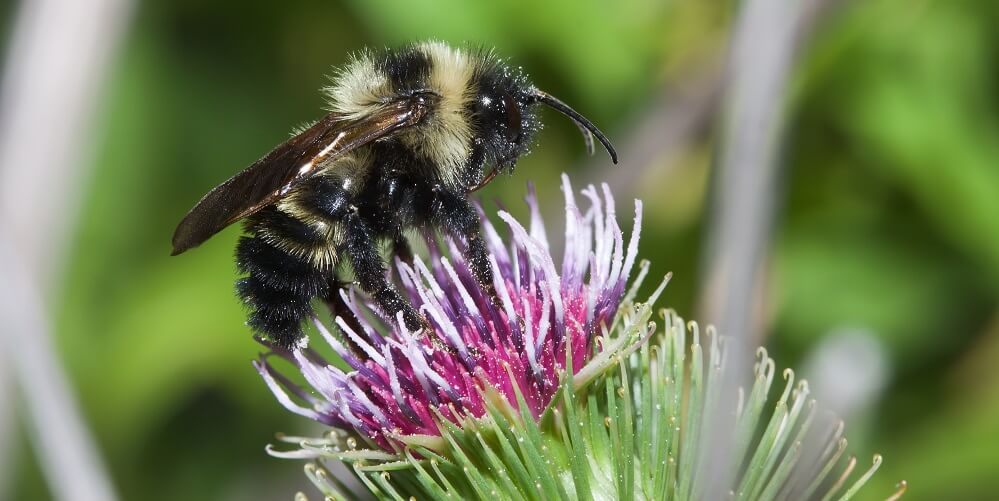
Pretty crazy, right?
Bees don’t have designated ears like humans do. Instead, they use their legs and antennae to detect vibrations that allow them to “hear” sound.
And get this:
Hearing vibrations is one way that honeybees communicate with each other. They do their famous “waggle dance,” which is when they vibrate their wings and abdomen.
Here’s the waggle dance in action:
So what’s the purpose of the waggle dance?
Simple.
When a worker bee finds a good source of nectar or pollen, she returns to her hive to perform a waggle dance to let her hive mates know where it’s located. Then they go out foraging for the food together.
This waggle dance takes place inside the hive, on top of the honeycomb.
Related: What Do Bees Eat?
4. Bees use their legs to clean themselves
This one is pretty straightforward, right?
But it shouldn’t be underestimated.
Maintaining a clean body and nest is crucial for bees because they’re constantly exposed to bacteria and micro-organisms. If they don’t keep themselves or their nest clean, it can lead to infections.
This is why if a bee dies near the nest, the other bees will tote them away to keep the area clean.
Also, bees use their front legs to clean their antennae. They even have special “antennae cleaners” to do the job.
Keeping their antennae clean is important because it helps the bee detect temperature, humidity, carbon dioxide, and wind speed. In fact, most of what a bee “knows” comes through using its antennae.
Related: Do Sweat Bees Sting or Bite?
5. Bees can use their legs for defense
Here’s a video of a bee grabbing and attacking a varroa mite:
Varroa mites are deadly.
They look like tiny ticks on bees, but they’re a different type of parasite than ticks. They have an uncontrollable appetite for a honeybee organ called the “fat body.” This organ serves many of the same vital functions carried out by the human liver.
Although varroa mites can feed on adult honeybees, they mostly feed and reproduce on larvae and pupae. This causes malformation and weakening of honeybees as well as transmits viruses.
This will weaken the immune system and potentially kill the bee. Even if the mite dies or leaves the bee, it’ll leave behind a hole in the bee’s exoskeleton that doesn’t heal, thus killing the bee.
Related: How Many Bees Are in a Hive?
6. Bees use their legs to build
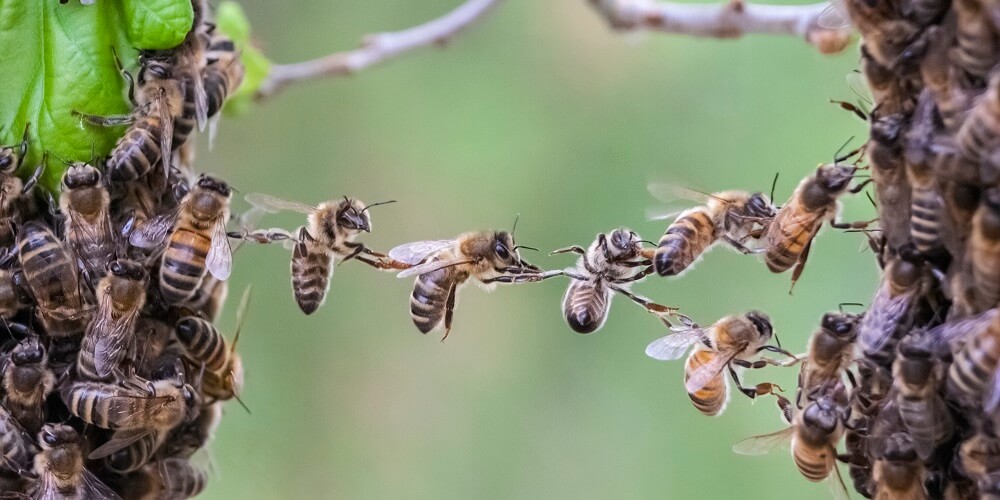
Have you ever seen bees hang together like a chain?
This is called festooning.
And why do they do it?
This behavior is observed when honeybees are building new comb or repairing old comb.
As a result, it’s believed that festooning is a construction job that happens when serious comb-work is underway. Linking together allows the bees to work more efficiently. It serves as a scaffold for them.
That said, sometimes festooning has been observed when bees aren’t building comb. This leads researchers to believe that bees use this technique for more than just construction.
Although, we aren’t sure of all the purposes yet. Some people think the purpose of festooning is to scaffold, while others believe it’s a method of measuring the distance between combs.
The bottom line?
As beekeepers or bee enthusiasts, we’re inspired by the many ways we see bees work together to reach common goals. And nothing says “teamwork” like these worker bees creating chains to get work done.
Related: Why Do Vulture Bees Eat Rotting Flesh?
7. Bees use their legs to gather things for nesting
Certain bees, like the wool carder bees, get their name because they collect fiber to use as nesting materials.
The female wool carders gather fibers by carding (aka scraping) them from plants. She then wads the fibers into a small ball and returns them to her nest.
They build their nests in preexisting holes or cavities, including hollow stems, dead wood, and man-made structures.
Here’s a wool carder bee using her legs to grab fibers:
Related: Do Carpenter Bees Pollinate?
Can a Bee Survive After Losing a Leg?
This is a tricky question to answer.
While bees can survive after an injury, it’s unclear for how long.
Bees have a strong instinct to work hard and carry on their job responsibilities. This will lead them to carry on as much as possible, despite having an injury.
This is also why bees quite literally work themselves to death. They work 10+ hour days, and when it’s their time to pass away, they just collapse.
Unfortunately, there hasn’t been much research on how long a bee can survive after losing a leg. My guess would be that they can survive, but they’ll probably have a shorter lifespan than other bees.
And unlike reptiles, bees can’t regrow lost legs once they’re gone.
Related: How to Get Rid of Carpenter Bees Naturally
FAQs on “How many legs do bees have?”
- What color legs do bees have?
- What are the parts of a bee’s leg?
- Do all bees have pollen baskets on their legs?
- How many legs do bumblebees have?
- Do bees have 4 legs?
What color legs do bees have?
Bees have black, brown, or otherwise dark-colored legs.
—> Go back to the FAQs on “How many legs do bees have?”
More to Explore:
What are the parts of a bee’s leg?
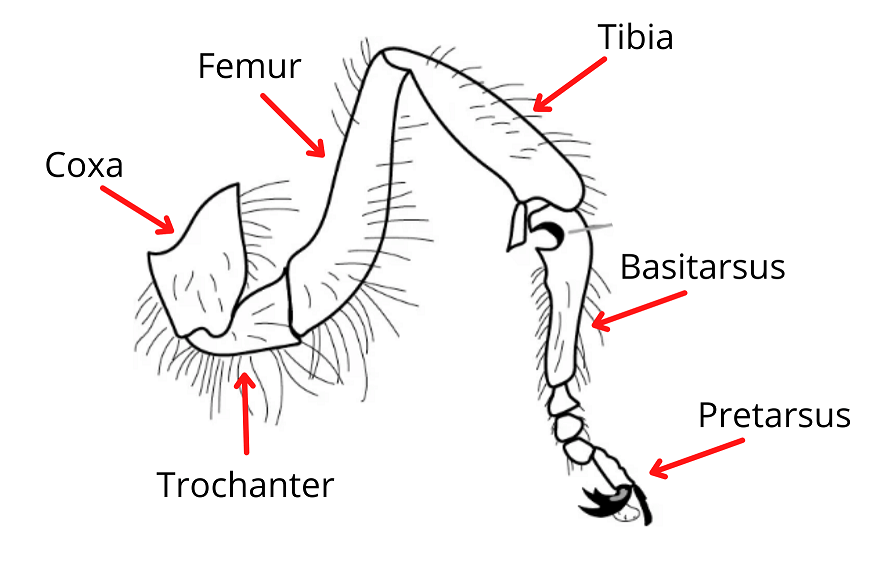
A bees leg consists of six sections:
1) The coxa
The coxa is what connects the bee’s leg to its body. It allows the bee to move its leg in different directions, sort of like a hinge.
The coxa on the front legs is pointed forward, while the coxa on the middle and back legs point backward.
2) The trochanter
The trochanter is a small but mighty section of a bee’s leg that allows it to move its leg upward and downward.
3) The femur
Yup, like humans, bees have femurs too.
Many people considered a bee femur to be its “thigh.”
The femur is attached to the bee’s knee (yes, bees have knees).
4) The tibia
Speaking of knees, the tibia is officially considered the knee of the bee and it’s very important.
For example, the tibia of bumblebees is flat, somewhat convex, glossy, and covered by hairs that are long and stiff. This forms what is called the pollen basket.
5) The basitarsus
The basitarsus is between the tibia and tarsus. And unlike the tibia, it doesn’t have any muscles in it. Instead, it has a tendon that runs through it, allowing for movement.
6) The pretarsus
This is considered the foot of the leg. It allows the bee to cling onto surfaces through “claws.”
Interestingly enough, bees leave behind a unique odor as they walk around. This helps them search for nectar.
—> Go back to the FAQs on “How many legs do bees have?”
More to Explore:
Do all bees have pollen baskets on their legs?
No, quite the opposite actually. Most bees just carry pollen loosely on their back legs.
But bumblebees and honeybees are the exceptions. They have designated pollen baskets that allow them to store pollen.
That’s right.
Bees don’t just move pollen between plants. They also bring it back to their nest for food. These are called “pollen pellets,” and they can also include small amounts of nectar.
And want to hear something surprising?
Pollen baskets can account for around 30% of a bee’s weight. (That would be like a 180-pound man carrying around 54 pounds of weight)
Pretty impressive, right? Who knew bees were so strong?
So how does this work?
To put it simply, the bee uses all six of her legs to scrape the pollen collected on her body down towards her back legs. This cleaning process allows her to fill her pollen basket full. This is when they fly back to their nest and empty their pollen sac.
Pollen allows bees to do many things – feed themselves, their queens, and the baby bees. Pollen is a bee’s main protein source. It also provides them with important vitamins and minerals they need in their diet.
—> Go back to the FAQs on “How many legs do bees have?”
More to Explore:
How many legs do bumblebees have?
We frequently get asked things like:
How many legs does a bumblebee have? How many legs does a carpenter bee have? How many legs do honeybees have?
The answer is that all bees have six legs. This is true for bumblebees, honeybees, carpenter bees, and different species of queen bees.
—> Go back to the FAQs on “How many legs do bees have?”
More to Explore:
- How to Keep Bees Away From Hummingbird Feeders
- Do Bees Have Lungs?
- Wasps vs. Honeybees: Are They Different?
Do bees have 4 legs?
Nope! Bees actually have six legs.
People often speculate on this topic because they haven’t seen a bee up close. So we often hear questions like, “How many pairs of legs do bees have?” or “How many legs does a bee have?” or finally, “Do bees have six legs?”
All bees have six legs, regardless of the species of bee.
